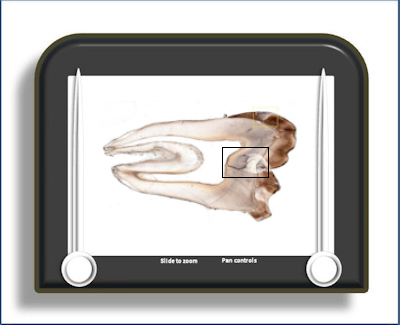Dentine and Pulp 4
Dentine lesion
This is a ground longitudinal section of a tooth showing a region where reactionary events have occurred within the dentine underlying a fissure caries lesion within the enamel. Note how the lesion in the dentine spreads wider than that visible in the overlying enamel because of the arrangement of the enamel prisms around the fissure and because of some lateral spread at the ADJ.
Sclerotic dentine: Sclerotic (or translucent) dentine arises because the dentinal tubules have been completely occluded by the laying down of additional peritubular dentine within the tubules by the odontoblasts. This occurs either as a general aging process or (as in this case) as a defensive mechanism in response to some overlying trauma (the caries lesion in enamel). This process only occurs if the progress of the lesion is slow enough to allow the cells to fill-in the tubules in good order. In this particular case initially the odontoblasts were able to accomplish this, hence the significant amounts of sclerotic dentine. However, subsequently the cells could not maintain this form of defence and withdrew their cell processes, leaving behind empty tubules (which during the grinding process fill with air and debris and appear black). This is a 'dead tract'.
Dead tract: If the odontoblast cannot mount an 'ordered' defence by producing sclerotic dentine then it will withdraw its cell process (or indeed may be killed) leaving an empty tubule which during the grinding process fills with air and debris and thus appears black. The odontoblast will (if still extant) attempt to seal the pulpal end of the tubule with reparative (or irregular secondary) dentine. If the odontoblasts are killed then this process is completed by sub-odontoblastic cells which produce a bone-like material.
Reparative (or irregular secondary) dentine: The reparative dentine is produced by odontoblasts in an attempt to seal the dentinal tubules to prevent direct access through the dentine to the pulp. In this situation it may itself be tubular. However, if the odontoblasts have been killed by the rapid progress of the lesion then this function of sealing the tubules will be taken over by sub-odontoblastic cells which produce a non-tubular bone-like material. In an attempt to clarify the nature of the defensive response, it has been proposed that reparative dentine produced by extant odontoblasts should be termed 'reactionary' dentine and the term 'reparative' should be reserved for situations where the original odontoblasts have died and have been replaced by subodontoblastic cells. In this section the 'new' dentine underlying the affected dentine does not appear to have tubules and therefore should be termed 'reparative' not 'reactionary' dentine.
To open the e-Scope, click on the demarcated area in the micrograph below:-
